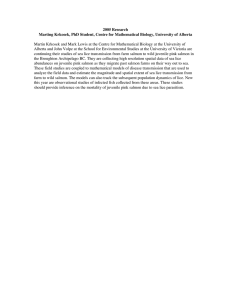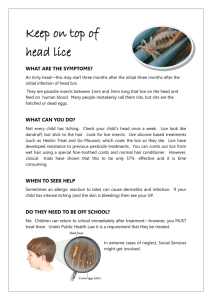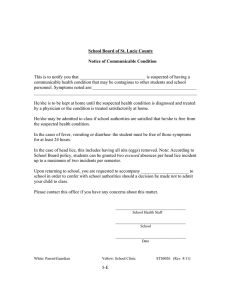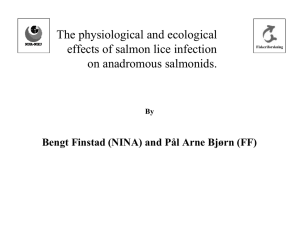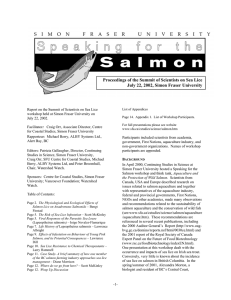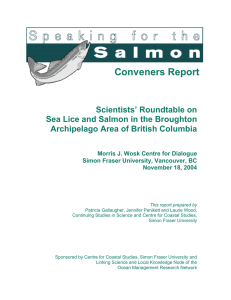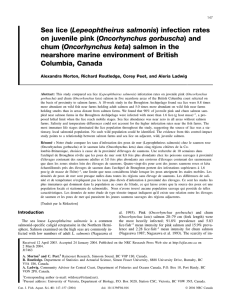Sunil Kadri Aquaculture Innovation
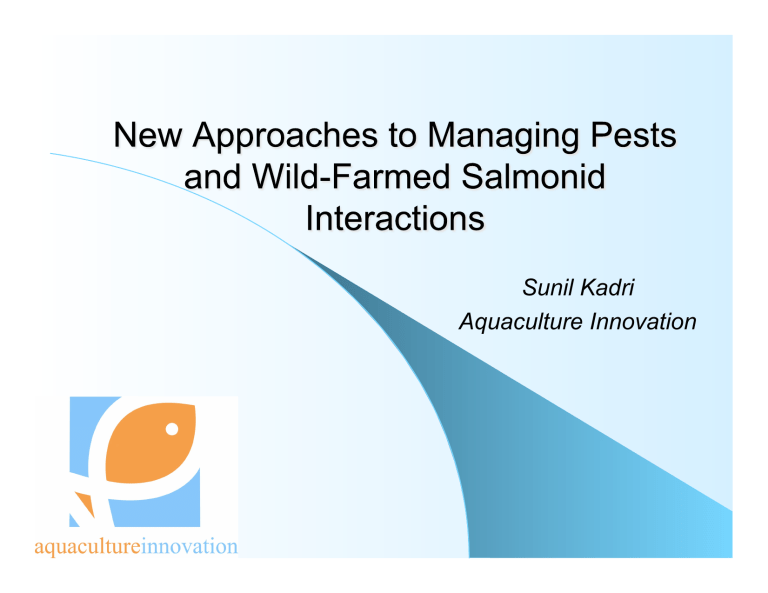
Sunil Kadri
Aquaculture Innovation
Will cover innovative approaches, not new means of doing the same old thing
–
No vaccines
–
No “best thing since SLICE”(d bread)
Sealice Management
–
Direct and indirect approaches
Wild-Farmed Interactions
–
Indirect approach
New hardware technology from
Scotland
Appears to reduce in parasite loadings in caged salmon: both lice and worms
Company claims improvements in overall fish health also
Bioemitter Systems in
Sealice Control
• Four units per cage
• Large units transmit an electromagnetic field
• Auxiliary units hold the electromagnetic field within the cage.
Bioemitter Systems in
Sealice Control
Sealice per Fish
7.0
6.0
5.0
4.0
3.0
2.0
1.0
.0
0 2 6 9 10 11 12 14 17 20 21 22 23 25 26
Gravids juveniles mobiles
“Blue-skies” approach to developing a novel method of preventing sealice infection in salmonids
Based upon the calcium sensing receptor
The Calcium Sensing Receptor (CaSR) Is A
Nutrient Salinity Sensor in Aquatic Organisms.
Amino Acids
Derivatives of Water Salinity
Ca 2+ , Mg 2+ , Na + and pH.
Outside
Cell Membrane
Inside
Structure & Function
Intracellular Alterations
Calcium Sensing Receptor (CaSR)
• Cellular ionic nutrient receptor.
• Present in most living organisms.
• Controls and influences fundamental
physiological processes
Confidential
Metamorphosis
Adult
Receptor-mediated
Settlement behaviors
Amino acids, peptides, ions, salinity
Receptor agonists, antagonists, modulators
Conspecific pheremones, biofilm compounds, metals, secondary metabolites
Settlement substrate
Inorganic or Living Surface
Habitat
Selection
Cyprid
Reproduction/ spawning Nauplii
Larval dispersal
The sensing properties of CaRs make them ideally suited to guide larval barnacles by integrating multiple known settlement and attachment cues.
Tidal Zones and Barnacles
Larval Barnacle Stage
Run-off
Rain Settlement
20-7ppt
Amino Acids and nutrients present
Gradients of water pH
Adult Barnacles
Ca 2+ and Attractant
Ca2+ and
Constant
Seawater
Replenishment
Evaporation
Confidential
Sea Lice and the CaSR
Sea lice are copepod crustaceans and their larval copepodids have only days to find suitable host – depend on environmental cues for targeting host salmon.
• Marked salinity preference for sea lice infestations. Low sal inities do not appear to be desirable or tolerable.
• Abundant CaSR in salmon skin. ? Parasitic – host interactions.
Confidential
220
120
80
Adult Caligus and L. Salmonis Possess CaSR Proteins
Immunoblot of Caligus
Crude Membrane Fraction
L. Salmonis
1
2
3
IMM #2
50
40
Confidential
IMM Pre-IMM
CaSRs are influenced by naturally occuring compounds such as minerals and amino acids
Presence of CaSRs in both sealice and salmon skin, provides two possibilities:
–
1. A “cue blocker” to prevent settlement, based upon an in-feed additive
–
2. A “lice trap” via provision of a very strong settlement cue
Example: adding a natural yeast cell wall product to animal diet
Modulates (as opposed to stimulates) immune system
Increases mucous production in the fish
Prolongs “zero-lice” period
Functional Nutrients From Yeast
Inner (polymer)
Inner and Outer Cell Wall
Whole yeast
Extract
Outer (manno-proteins)
Modification of intestinal microorganisms
Pathogen binding & direct elimination from the gut
Improved intestinal morphology & structure
Improved nutrient availability & growth performance
Improved immune response
Improved disease resistance
Marine Harvest Scotland - Identification of sea lice
AF
AF
AM
PA
G
CHALIMUS
CALIGUS AM
Control
(Pen 3)
Average weight of mucous g
Day 2 Day 12 Day 22 Day 35
0.1181 0.392 0.40 0.405
Bio-Mos
(Pen 14)
0.1181 0.4765 0.605 0.827
0.9
0.8
0.7
0.6
0.5
0.4
0.3
0.2
0.1
0
D-2
Mucus development on Salmon @ Arran June / July 2007 through BioMos ( pen 14 )
D+10 D+22 D+33 time pen 3 pen 14
Bio-Mos inclusion 6kg/ton feed
P<0.05
Average
20-Aug-07 Control BioMos
Fertile females
Moving lice
Larvaes
Skotte (Caligus elongatus)
Sum
03-Sep-07
3.5
14.25
5
12
34.75
Fertile females
Moving lice
Larvaes
Skotte (Caligus elongatus)
1
30.75
15
12.5
0.5
22
9.25
8.75
Sum 59.26
40.5
4 control cages and 4 Bio-Mos cages
– Bio-Mos inclusion 4kg/ton feed
0.5
1.75
0.75
15
18
T test
0.08
0.1
0.11
0.14
0.05
0.18
0.18
0.17
0.14
0.04
Provides high level production performance on all sites
Allows location of sites in areas which might otherwise be unsuitable for maximising fish performance
Presently at prototype stage
= Swimming reaction to a moving visual background
Natural innate mechanism enabling position stabilisation
(e.g. schooling, station holding in fast flows)
Potential to control swimming speed w/o currents
Mechanical research devices
3-fold increase in swimming speed
36% increase in SGR
21% improvement in FCR
45% drop in basal stress (cortisol)
There are alternatives to the pharma approaches
These provide means for aquaculture sustainability through innovation in pest management and fish health in general

